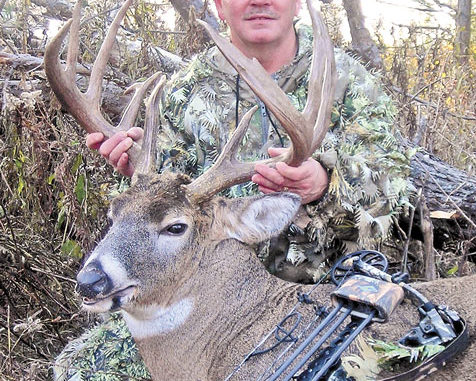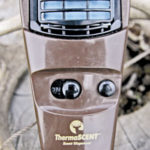
Scents smell horrible to us, but when used properly, there are few things a deer likes more.
The unmistakable sound of crusted snow giving way to the weight of a deer’s hooves broke the silence from somewhere up the right-of-way, alerting me to its presence.
With each passing moment, the crunching sound drew slowly closer.
It was the time of year daylight is a rare commodity in the North Country and temperatures hover in the mid-teens much of the day, dropping dramatically by late afternoon. These are the conditions where chattering teeth, knocking knees and uncontrollable torso shivers, more resembling convulsions, cause you to question your sanity.
“What’s-ka-keep-ing-tha-t-da-deer?” I whispered to myself, trying to control something that would be likened to harnessing the LSU student section in Death Valley after the Tigers scored a touchdown.
It wasn’t happening — a full-fledged case of the shakes had taken over.
Suddenly, the deer came into view — a doe. And what caused her to delay was me. In every one of my boot tracks, she stuck her nose to sniff — first the left, then the right, methodically pulling in sensory snorts of artificial smell.
But the cold had beaten me. Not only was I unable to get my bow into position, my aluminum arrow tapped from my shaking against the arrow rest like a percussionist doing a drum roll. She spooked, and bolted off.
I was 23 years old back then, but that late afternoon left an indelible image in my mind. Prior to leaving my truck, I rubbed fox urine cover scent that I had picked up at a local sporting goods store all over my boots. I had never used such products before.
Now 30 years later, when it comes to buck lures, cover scents and attractants, I’m still putting out the “poo-yi,” only now in the sportsman’s paradise.
In the 30 years since that first encounter, scent products, and the methods for dispensing them, have advanced. But all still work off the same principle primitive man, indigenous Native Americans and trappers discovered long ago to harvest animals — use the animal’s best defense against it.
Ron Bice, communications director for Wildlife Research Center, says using scents is smart hunting.
“Deer can smell at least 1000 times better than you and I, and they literally live and die by their sense of smell,” said Bice, who has taken several nice bucks over the years while bowhunting. “Using a scent is a great tool while hunting deer. It only makes sense that we can take advantage of this knowledge. Using a scent that is attractive to an animal to draw them in close is just smart hunting.”
Over the past several decades, deer hunting has evolved to the point where less and less stalking-type hunting is being done. Instead of getting out and tracking an animal, or putting the wind in your face and slowly creeping deer cover, the vast majority of hunters are now in above-ground fixed positions.
Comfortable shooting houses, food plots and automated feeders along with other technology are part of the business that has contributed to the prevailing attitude of getting deer to come to you. Even a caveman would have preferred a couch to sit on while waiting for his next meal to come along to spear.
Cover scents, estrus-type buck lures and the various attractants are a natural fit with stand-hunting methods today. According to Bice, the technology used in the research where these products are concerned has also come a long way.
“As we research the effect a certain smell has to a deer, we rely on a number of factors,” he said. “Obviously, observation of a scent set up — watching deer reaction — is a good start.
“In the beginning we relied on track counts. Basically, the number of tracks that surrounded a scent set up in mud, snow, etc. In the beginning, this was critical information. Today, we rely on trail cameras to give that insight that wasn’t available years back.”
Do scents work or are they simply part of the broader “business” of deer hunting today?
Scott Durham, Louisiana Department of Wildlife and Fisheries biologist, prefers not to regularly use scents, but admits to using them in the past.
“I used a little of that doe lure back when I was a kid, putting it out making mock scrapes and things like that,” he said. “But I just don’t use them much. I set up on good trails with lots of activity and food sources. When I’ve used some of those products, I have had spikes and does, not big old bucks, kind of react to them and sniff them and get curious about them. I do know guys who use them. And if (deer) get a whiff of you, it doesn’t matter what you use as a cover scent or attractant.”
Bice cautions hunters that the best scent set up in the world is often contaminated by their own odor and poor techniques in putting them out.
“The most common mistake,” Bice warned, “is hunters contaminating the set up with their own human scent. The best, most attractive scent in the world to a deer isn’t one that has been contaminated by human odor. This smell may very well be the most feared scent there is to a deer. Making sure to shower in Scent Killer body wash, as well as making sure your clothes have been washed in Scent Killer, will help a lot.”
Additionally, Bice suggests spraying boot bottoms with Scent Killer and using rubber gloves when putting out lures and attractants to ensure the most pristine set up possible.
Using a doe-type curiosity scent a number of years ago, no fewer than five does came out and hung around the oak tree I sat in. Several of them stood on their hind legs in order to reach and get a whiff of the scent I had placed above the ground around my stand.
Back then, Louisiana had designated doe days. Since this wasn’t one of them, I watched and waited for a buck. A short time later, a young buck did show that I immediately harvested.
There are numerous wicks, gadgets and dispensers on the market today for dispersing scent into the atmosphere for deer to get a snort of. Everything from retractable wick dispensers to those designed to heat lures, causing more efficient evaporation into the atmosphere, is available.
No doubt, some are gimmicks, but others do an excellent job of getting scent into the air currents surrounding your elevated stand. The key to all of these products is taking time to scout the area you intend to use them looking for rub lines, scrapes and active trails leading to and from food sources.
A deer’s life pretty much centers on its stomach, other than the period during the rut. Essentially, they must feed, rest and procreate. All lures and attractants take these activities into consideration. How you match them to the specific location you hunt, dispense them and handle them will impact the success you’ll have using them.
Lastly, estrus-type lures, urines and musk products can be smelly, causing that “poo-yi” reaction. If suddenly you notice Fido rolling on your hunting clothes, chances are your techniques in handling scent products may require some improvements. Be sure to keep it clean by replacing caps tightly, using rubber gloves when handling dispensers and wicks and carrying along a sealable plastic bag to store products in.
Nothing can be more fun to watch than a deer’s reaction to the scent products available on the market today. When done right, to them the poo-yi is like a euphoric perfume.









